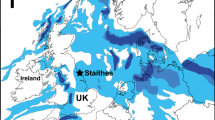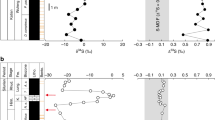Abstract
Replying to: S.-Y. Jiang et al. Nature 459, 10.1038/nature08048 (2009)
Jiang et al.1 present a new SHRIMP U–Pb zircon age of 532.3 ± 0.7 million years (Myr) ago for an ash bed in the lowermost black shale sequence of the Niutitang Formation, China, and claim that the data presented in our recent paper2 do not firmly support the idea that the biological and environmental changes at the Precambrian/Cambrian transition can be explained by a single global hydrogen sulphide (H2S) release event. Their new age seems to be supported by another recent SHRIMP investigation3 which indeed suggests that the Chinese metal-enriched sulphide layer does not represent the Precambrian/Cambrian boundary and shows that the redox history of both basins (Oman and South China) was much more complex.
Similar content being viewed by others
Main
However, as outlined previously4, SHRIMP data are not always reliable when it comes to solving stratigraphical problems. For example, with regards to the Yangtze platform, SHRIMP data on the lowermost Doushantuo Formation gave an age of 621 ± 7 Myr ago5, whereas single zircon U–Pb data gave an age of 632.5 ± 0.5 Myr ago6. This offset is very similar in value and direction to the offset between the Precambrian/Cambrian boundary and the SHRIMP age of Jiang et al.1. If indeed this is related to a systematic inaccuracy of the applied SHRIMP technique, it seems inevitable that single zircon analyses must be undertaken to solve the age problem in the case under discussion.
New age data7 confirm an age of 542–541 Myr ago for the base of the Ara A4 cycle, and point to a stratigraphic time interval for the measured section of ∼1 Myr. This is in good agreement with the time generated by our model, in favour of an ocean overturn in the lowermost Cambrian. If the age of 532.3 ± 0.7 Myr ago in China can be confirmed, the Mo isotopic signals from Oman and South China would be of diachronous origin. They would thus reflect two successive events, each one less resolved than the initially suggested combined profile. This would affect the temporal resolution and render the quantifications of the model of ref. 2 more uncertain, but would not affect the model’s main qualitative conclusion. The most plausible explanation for the Mo isotopic excursions observed in both basins in combination with the same overall Mo isotopic composition is a transient Mo seawater signal caused by excess H2S.
Jiang et al.1 seem to suggest that the unusual metal enrichment in the Chinese black shales may not be related to scavenging from sea water in a euxinic environment, but from sea-floor hydrothermal venting. However, our Mo isotope data exclude a hydrothermal origin of molybdenum, which is the element most enriched in these rocks, together with a broad suite of other redox-dependent metals8. The consistent δ98/95Mo value of 1.1 ± 0.1‰ in the basal sulphide marker bed defines the Mo isotope composition of the sea water at that stratigraphic time interval, and the subsequent oscillation of Mo isotope composition in the overlying shale attests to a transitional seawater signal. It remains to be tested in other stratigraphic sections if this oscillation is indeed a global signal, possibly over an extended 10-Myr time interval in the Early Cambrian.
References
Jiang, S.-Y. et al. Early Cambrian ocean anoxia in South China. Nature 459 10.1038/nature08048 (2009)
Wille, M., Nägler, T. F., Lehmann, B., Schröder, S. & Kramers, J. D. Hydrogen sulphide release to surface waters at the Precambrian/Cambrian boundary. Nature 453, 767–769 (2008)
Chen, D., Wang, J., Qing, H., Yan, D. & Li, R. Hydrothermal venting activities in the Early Cambrian, South China: Petrological, geochronological and stable isotope constraints. Chem. Geol. 258, 168–181 (2009)
Bowring, S. A., Grotzinger, J. P., Condon, D. J., Ramezani, J. & Newall, M. J. Reply to comment: Oman Chronostratigraphy. Am. J. Sci. 309, 91–96 (2009)
Zhang, S. H. et al. U-Pb sensitive high-resolution ion microprobe ages from the Doushantuo Formation in south China: Constraints on late Neoproterozoic glaciations. Geology 33, 473–476 (2005)
Condon, D. et al. U-Pb ages from the Neoproterozoic Doushantuo Formation, China. Science 308, 95–98 (2005)
Bowring, S. A. et al. Geochronologic constraints on the chronostratigraphic framework of the Neoproterozoic Huqf Supergroup, Sultanate of Oman. Am. J. Sci. 307, 1097–1145 (2007)
Lehmann, B. et al. Highly metalliferous carbonaceous shale and Early Cambrian seawater. Geology 35, 403–406 (2007)
Author information
Authors and Affiliations
Rights and permissions
About this article
Cite this article
Wille, M., Nägler, T., Lehmann, B. et al. Wille et al. reply. Nature 459, E6 (2009). https://doi.org/10.1038/nature08049
Issue Date:
DOI: https://doi.org/10.1038/nature08049
This article is cited by
Comments
By submitting a comment you agree to abide by our Terms and Community Guidelines. If you find something abusive or that does not comply with our terms or guidelines please flag it as inappropriate.



